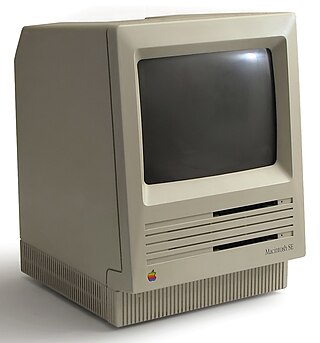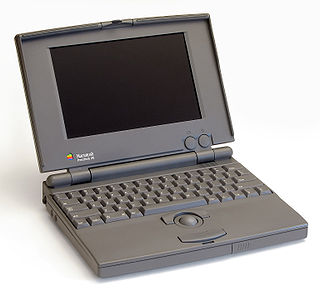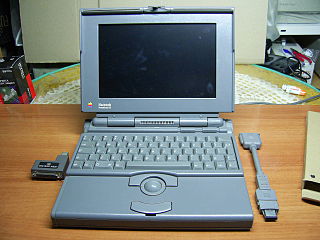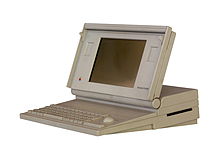
The PowerBook is a family of Macintosh laptop computers designed, manufactured and sold by Apple Computer from 1991 to 2006. During its lifetime, the PowerBook went through several major revisions and redesigns, often being the first to incorporate features that would later become standard in competing laptops. The PowerBook line was targeted at the professional market. In 1999, the line was supplemented by the home and education-focused iBook family.

The Macintosh Plus computer is the third model in the Macintosh line, introduced on January 16, 1986, two years after the original Macintosh and a little more than a year after the Macintosh 512K, with a price tag of US$2,599. As an evolutionary improvement over the 512K, it shipped with 1 MB of RAM standard, expandable to 4 MB, and an external SCSI peripheral bus, among smaller improvements. Originally, the computer's case was the same beige color as the original Macintosh, Pantone 453; however, in 1987, the case color was changed to the long-lived, warm gray "Platinum" color. It is the earliest Macintosh model able to run System Software 5, System 6, and System 7, up to System 7.5.5, but not System 7.5.2.

The Macintosh SE is a personal computer designed, manufactured, and sold by Apple Computer, from March 1987 to October 1990. It marked a significant improvement on the Macintosh Plus design and was introduced by Apple at the same time as the Macintosh II.

The PowerBook Duo is a line of subnotebooks manufactured and sold by Apple Computer from 1992 until 1997 as a more compact companion to the PowerBook line. Improving upon the PowerBook 100's portability, the Duo came in seven different models. They were the Duo 210, 230, 250, 270c, 280, 280c, and 2300c, with the 210 and 230 being the earliest, and the 2300c being the final incarnation before the entire line was dropped in early 1997.

The PowerBook G3 is a series of laptop Macintosh personal computers designed, manufactured, and sold by Apple Computer from 1997 to 2001. It was the first laptop to use the PowerPC G3 (PPC740/750) series of microprocessors, and was marketed as the fastest laptop in the world for its entire production run. The PowerBook G3 was succeeded by the PowerBook G4.

The Macintosh Classic II is a personal computer designed and manufactured by Apple Computer, Inc. from October 1991 to September 1993. The system has a compact, appliance design with an integrated 9" monitor, typical of the earliest of the Macintosh range. A carrying handle moulded into the case added a degree of portability at a time when laptops were still relatively uncommon.

The Macintosh Quadra 950 is a personal computer designed, manufactured and sold by Apple Computer from March 1992 to October 1995. It replaced the Quadra 900 that was introduced several months earlier, increasing the CPU clock rate of its 68040 CPU from 25 MHz to 33 MHz, and improving the graphics support. The two computers were otherwise identical, including the price. With a Macintosh Processor Upgrade Card installed, this computer is known as the Power Macintosh 950.
Outbound Systems, Inc., was an American computer company based in Boulder, Colorado. Founded by Warren Conner in 1989, the company offered Macintosh clone computer systems in various portable form factors between 1989 and 1991. It left the Mac conversion business in 1992 to build windows-based desktop computers before going bankrupt in 1993.

The PowerBook 500 series is a range of Apple Macintosh PowerBook portable computers first introduced by Apple Computer with the 540c model on May 16, 1994. It was the first to have stereo speakers, a trackpad, and Ethernet networking built-in.

The LTE is a line of laptops manufactured by Compaq Computer Corporation, introduced in 1989 and discontinued in 1997. It was the first notebook-sized laptop sold by Compaq and the first commercially successful notebook computer that was compatible with the IBM PC.

The Macintosh Quadra 605 is a personal computer designed, manufactured, and sold by Apple Computer from October 1993 to July 1996. The model names reflect a decision made at Apple in 1993 to follow an emerging industry trend of naming product families for their target customers – Quadra for business, LC for education, and Performa for home. Accordingly, the Performa 475 and 476 was sold in department stores and electronics stores such as Circuit City, whereas the Quadra was purchased through an authorized Apple reseller.

The PowerBook 100 is a portable subnotebook personal computer designed and manufactured by Sony for Apple Computer and introduced on October 21, 1991, at the COMDEX computer expo in Las Vegas, Nevada. Priced at US$2,500 with external floppy drive, the PowerBook 100 was the low-end model of the first three simultaneously released PowerBooks. Its CPU and overall speed closely resembled those of its predecessor, the Macintosh Portable. It had a Motorola 68000 processor at 16 MHz, 2-8 megabytes (MB) of RAM, a 9-inch (23 cm) monochrome backlit liquid-crystal display (LCD) with 640 × 400 pixel resolution, and the System 7.0.1 operating system. It did not have a built-in floppy disk drive and was noted for its unique compact design that placed a trackball pointing device in front of the keyboard for ease of use.

The PowerBook 180 is a portable computer released by Apple Computer along with the PowerBook 160 in October 1992. At the time, it constituted the new top-of-the-range model, replacing the previous PowerBook 170. Its case design and features are the same as that of the 170, but it shipped with the more powerful 33 MHz Motorola 68030 CPU and Motorola 68882 FPU. Along with the 160, it introduced a new power-saving feature which allowed the processor to run at a slower 16 MHz rate, the same speed as the original 140.

The PowerBook 140 was released in the first line of PowerBooks. It was the mid-range PowerBook, between the low-end 100 and the high-end 170. As with the PowerBook 170, and unlike the 100, this PowerBook featured an internal floppy drive. Codenames for this model are: Tim Lite, Tim LC, Replacements, and Leary. In 1992, it was replaced by the PowerBook 145, which was essentially a speed bump, though the PowerBook 160 essentially superseded it as the new mid-line model.

The PowerBook Duo 210 is a portable subnotebook personal computer, manufactured by Apple Computer Inc. and introduced in October 1992. Priced at US$2250, the PowerBook Duo 210 was the low-end model of the two simultaneously released PowerBook Duos. The specifications of the PowerBook Duo 210 are almost identical to the PowerBook 160, except that the PowerBook Duo 210 has a smaller display. Its case design is identical to the PowerBook Duo 230, but it shipped with 25 MHz Motorola 68030, instead of the faster 33 MHz 68030 on the Duo 230. The PowerBook Duo 210 had a 80MB SCSI Hard Disk Drive. It was discontinued on October 21, 1993.

The PowerBook 160 is a portable computer that was released by Apple Computer along with the PowerBook 180 on October 19, 1992 and the PowerBook 165 variants were released the following year. At the time, it constituted the mid-range model replacing the previous PowerBook 140 in processing power. The PowerBook 160 was sold until August 16, 1993.

The PowerBook 150 is a laptop personal computer created by Apple Computer which was introduced on July 13, 1994, and released on July 18, 1994. It was the last member of the PowerBook 100 series to use the original case design, the most affordable of the series when introduced and also the last consumer model.

The history of laptops describes the efforts, begun in the 1970s, to build small, portable Personal Computers that combine the components, inputs, outputs and capabilities of a Desktop Computer in a small chassis.
To date, two methods have been used to make a personal computer, not offered by Apple, but able to run a Mac operating system: either create a Macintosh conversion or build a Macintosh clone.

The SupersPort is a line of PC-compatible laptops manufactured by Zenith Data Systems and sold from 1988 to 1993. The first two main entries in the SupersPort line included either an Intel 80286 microprocessor clocked at 12 MHz or an 8088 processor clocked at 8 or 4.77 MHz, switchable. Later entries included the 386SX, 486SX and 486 processors. The SupersPort 286 in particular was one of the top-selling laptops of the late 1980s, although Zenith's position in this segment faltered by the early 1990s.



















